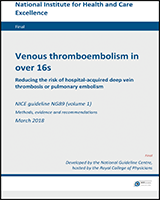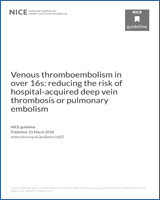NCBI Bookshelf. A service of the National Library of Medicine, National Institutes of Health.
National Guideline Centre (UK). Venous thromboembolism in over 16s: Reducing the risk of hospital-acquired deep vein thrombosis or pulmonary embolism. London: National Institute for Health and Care Excellence (NICE); 2018 Mar. (NICE Guideline, No. 89.)
December 2019: In recommendation 1.3.5 the British Standards for anti-embolism hosiery were updated because BS 6612 and BS 7672 have been withdrawn. August 2019: Recommendation 1.12.11 (1.5.30 in this document) was amended to clarify when anti-embolism stockings can be used for VTE prophylaxis for people with spinal injury.

Venous thromboembolism in over 16s: Reducing the risk of hospital-acquired deep vein thrombosis or pulmonary embolism.
Show details24.1. Introduction
The use of lower limb immobilisation techniques in trauma and elective orthopaedic surgery affects a significant number of patients. The populations involved include trauma patients who do not require surgery, trauma patients who have had operative fixation, and elective cases usually involving the knee, foot and ankle. Immobilisation (such as with a plaster cast or brace) may be used for 3 months or more following the intervention. Certain groups may be at greater risk for VTE, for example patients undergoing conservative or operative treatment for rupture of the tendoachilles and patients undergoing more complex procedures with longer immobilisation.
24.2. Review question: What is the effectiveness of different pharmacological and mechanical prophylaxis strategies (alone or in combination) in people with lower limb immobilisation?
For full details see review protocol in appendix C.
Table 1
PICO characteristics of review question.
24.3. Clinical evidence
Twelve studies were included in the review41 ,77 ,78 ,155 ,168 ,172 ,178 ,179 ,185 ,263 ,269 ,301; these are summarised in Table 2 below. Six studies were included from the previous guideline (CG92) 155 ,168 ,172 ,178 ,179 ,185. Six studies were added in the update41 ,77 ,78 ,263 ,269 ,301. Evidence from these studies is summarised in the clinical evidence summary below (Table 3, Table 4, Table 5, Table 6). See also the study selection flow chart in appendix E, forest plots in appendix L, study evidence tables in appendix H, GRADE tables in appendix K and excluded studies list in appendix N.
The included studies cover a heterogeneous population of surgically and non-surgically treated patients with injuries as diverse as simple ankle fractures to those with Achilles tendon ruptures. The evidence features a number of different immobilisation techniques (for example plaster cast or brace), and there is large variation in the duration of immobilisation, ranging from 2 weeks to 6 weeks.
Table 2
Summary of studies included in the review.
Table 3
Clinical evidence summary: IPCD (below knee) versus no VTE prophylaxis.
Table 4
Clinical evidence summary: LMWH (standard prophylactic dose) versus no VTE prophylaxis.
Table 5
Clinical evidence summary: Fondaparinux versus LMWH (standard prophylactic dose).
Table 6
Clinical evidence summary: Fondaparinux versus no VTE prophylaxis.
24.4. Economic evidence
Published literature
No relevant health economic studies were identified.
See also the health economic study selection flow chart in appendix F.
24.5. Evidence statements
Clinical
Very low quality evidence from one study showed no difference in PE rates between IPCD and no prophylaxis, however there was uncertainty around this result. Very low quality evidence from two studies suggested an increased DVT risk when using IPCD although there was serious imprecision around this effect estimate indicating that the true effect could be consistent with no clinical difference.
When comparing either LMWH or Fondaparinux with no prophylaxis, moderate quality evidence showed that both LMWH (8 studies) and Fondaparinux (1 study) provided a clinically important reduction in DVT compared to no prophylaxis. In head to head comparisons, moderate quality evidence from 2 studies showed a benefit for fondaparinux over LMWH with a clinically important reduction in DVT. However on the basis of very low quality evidence, no clinical difference was observed for all other critical outcomes (all-cause mortality, fatal PE, PE and major bleeding) when comparing LMWH, fondaparinux, or no prophylaxis. There was very serious imprecision associated with all of the outcomes apart from DVT.
Economic
No relevant economic evaluations were identified.
24.6. Recommendations and link to evidence
| Recommendations | |
| Research recommendation |
|
| Relative values of different outcomes |
The committee considered all-cause mortality (up to 90 days from hospital discharge), deep vein thrombosis (symptomatic and asymptomatic) (up to 90 days from hospital discharge), pulmonary embolism (up to 90 days from hospital discharge), fatal PE (up to 90 days from hospital discharge), and major bleeding (up to 45 days from hospital discharge) as critical outcomes. The committee considered clinically relevant non-major bleeding (up to 45 days from hospital discharge), health-related quality of life (up to 90 days from hospital discharge), heparin-induced thrombocytopaenia (duration of study), and technical complications of mechanical interventions (duration of study) as important outcomes. Please see section 4.4.3 in the methods chapter for further detail on prioritisation of the critical outcomes. |
| Quality of the clinical evidence |
The majority of the evidence is of very low quality due to high risk of bias and imprecision around the effect estimates. One study also provided indirect evidence due to a mix of standard and high doses of LMWH being used. For the comparison between IPCD and no prophylaxis, the evidence for both DVT and PE was all of very low quality. For the comparison between LMWH and no prophylaxis, and for the comparison of fondaparinux with LMWH, all the evidence was of very low quality except for the DVT outcome where the evidence was of moderate quality (no imprecision). |
| Trade-off between clinical benefits and harms |
The use of lower limb immobilisation following trauma and elective orthopaedic surgery affects a significant number of patients. This is also highly heterogeneous group of patients, represented by a wide variation of DVT rates reported in the no prophylaxis arms. The studies included both patients admitted for their trauma and those treated and discharged in the trauma department. Based on the clinical evidence presented, no clinically important difference was found between IPCD and no prophylaxis. Due to the imprecision associated with the results, the committee considered that the evidence base was not strong enough in this context to recommend IPCD in this population. LMWH showed a clinically important reduction in DVT. There was also a suggested reduction in PE and increase in major bleeding, however these differences were too small to be considered clinically important and there was considerable uncertainty around the results. Fondaparinux also showed a clinically important reduction in DVT alongside a suggested decrease in PE, although this second finding was very imprecise and no major bleeding events were noted in either group. The studies comparing fondaparinux versus LMWH (standard dose) also showed a clinically important reduction in DVT when using fondaparinux compared to LMWH. However the point estimates for all-cause mortality and major bleeding all favoured LMWH, but these findings did not reach clinical importance and there was uncertainty around the effect. The committee considered that overall the evidence did not support one treatment over another, therefore either should be recommended for those at high risk of VTE in the population with lower limb immobilisation. There is a range of procedures and injuries which require the application of lower limb immobilisation. The length of the immobilisation/cast and the location of injury within the leg may also differ. The committee recognised that baseline mobility can be difficult to assess and that the risk of VTE associated with lower limb immobilisation is most easily defined by the duration of immobilisation. The committee decided to recommend prophylaxis for 42 days based on the lower limb immobilisation information provided within the trials included in this evidence review. Most patients are expected to remain mobile (although not weight bearing on the affected limb), while others may remain immobile, generally. These are the factors which may put patients at different levels of risk. The committee acknowledged that for the subgroup of patients with tendo-Achilles rupture, who are at higher risk of VTE, prophylaxis should be offered. The ‘consider’ recommendation is a reflection of the very low to moderate quality evidence. However, it is the committee’s belief that for this group of patients, prophylaxis with LMWH (standard dose) is likely to be most clinically and cost effective compared with subgroups with ankle fractures (whether operated or not operated on) and soft tissue injuries. |
| Trade-off between net clinical effects and costs |
No relevant economic studies were identified for this review. Unit costs were presented to the committee for discussion alongside the clinical evidence. The committee discussed the duration of prophylaxis and acknowledged that in this population, the cost of prophylaxis is likely to be higher compared to other populations due to the longer duration for which prophylaxis is required, which ranges from 2 to 6 weeks. The committee acknowledged that durations of immobilisation that are longer than 6 weeks are likely to be rare. Prescribing pharmacological prophylaxis for these long durations will need to be decided on an individual basis, balancing the risk of VTE with the risk of bleeding. The committee considered that LMWHs and fondaparinux are the only interventions with clinical evidence that show clinical benefit in terms of DVT prevention to support a recommendation. Studies that compared LMWH with fondaparinux suggested a clinical benefit for fondaparinux over LMWH for the outcome of DVT, but less clear evidence of benefit for other critical outcomes. Given the higher cost of fondaparinux (£4.4 per day compared to a range of £2.77 to 3.03 for LMWHs) it was considered that it may not be as cost-effective as LMWH but that it could be recommended as an option; as some individuals would have contraindications to LMWHs. The committee acknowledged that in current practice clinicians usually default to using LMWH, unless there are contraindications. |
| Other considerations |
The committee noted that these recommendations apply to all patients who are immobilised by a cast or brace and that includes patients: admitted to hospital for treatment, treated as day procedures and those treated as outpatients in the trauma department and discharged straight after. The higher risk patients are likely to be those admitted for their treatment but this is not clear from the evidence and therefore the recommendation applies to all patients. The committee noted the lack of evidence for the clinical and cost-effectiveness of DOACs in this population (rivaroxaban, apixaban and dabigatran) and suggested a research recommendation would be beneficial looking at these interventions in comparison with LMWH and/or fondaparinux; see appendix R for more details. |
Footnotes
- b
At the time of publication (March 2018), LMWH did not have a UK marketing authorisation for use in young people under 18 for this indication. The prescriber should follow relevant professional guidance, taking full responsibility for the decision. Informed consent should be obtained and documented. See the General Medical Council’s Prescribing guidance: prescribing unlicensed medicines for further information.
- c
At the time of publication (March 2018), fondaparinux sodium did not have a UK marketing authorisation for use in young people under 18 for this indication. The prescriber should follow relevant professional guidance, taking full responsibility for the decision. Informed consent should be obtained and documented. See the General Medical Council’s Prescribing guidance: prescribing unlicensed medicines for further information.
- Lower limb immobilisation - Venous thromboembolism in over 16sLower limb immobilisation - Venous thromboembolism in over 16s
Your browsing activity is empty.
Activity recording is turned off.
See more...
